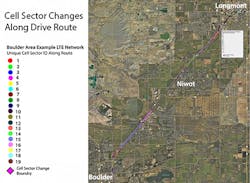How often do you think about how your smartphone or tablet maintains its signal?
What about in mobile situations, such as being in a vehicle traveling through a mix of rural and urban areas? While most people notice when a call gets dropped or data doesn’t go through, it’s probably not something most think about until it affects them. For most users, a lost signal or connection is a temporary annoyance. However, for FirstNet’s future users—law enforcement officers, firefighters, paramedics and other emergency personnel who are always on the go—having a reliable connection is critical.
This is one area in which FirstNet’s Innovation and Test Lab (FirstNet Lab) will help. The FirstNet Lab at our technical headquarters in Boulder, CO, is a state-of-the-art facility where FirstNet and its future partners will test public safety functionality and features unique to FirstNet’s mission-critical broadband network. This includes key mission-critical services, such as quality of service; priority; preemption; and other future services and applications.
The FirstNet Lab will also support research and feature verification efforts related to public safety technologies. This will help reduce the amount of time it takes to get mission critical technologies into the hands of public safety.
The lab is open and prepared to host network equipment to support lab test activities once the public/private partnership is in place. To further prepare the lab, the FirstNet CTO staff is currently conducting a number of general LTE tests on commercial networks. As part of the analysis, FirstNet’s device team completed local LTE mobility testing using the FirstNet Lab’s LTE devices, as well as data collection, post processing, and mapping tools.
FirstNet started by testing mobile connectivity over an 11.8-mile route, from FirstNet’s technical headquarters in the northeast area of Boulder to the town of Longmont, CO. The route weaved along Highway 119, passing through the small towns of Gunbarrel and Niwot. This is a popular commuter route with a mixture of suburban and rural areas.
An LTE network is comprised of many cell sites, which are typically deployed as three sectors, separated by 120-degree at each location. As FirstNet drove the route, data was collected from a smartphone while in idle mode and moving between the coverage area of different cell sites and sectors along the route. The mobility test data was then post-processed and mapped to show which cell sector the device was connected to along the route.
The resulting map provides an example of the cell density along the route. It also demonstrates the reliability of access to the network and the complexity of cell sector changes the device had to move through on the route to maintain its service-ready status.
The following details describe the specific observations from the test data FirstNet collected. Of particular interest was the cell sector and LTE frequency information.
Cell sector density
The device selected 19 different sectors that were identified by unique physical cell identity values while traversing the route in idle mode. A total of 20 sector change boundaries were observed along the test route, averaging a sector change every 0.59 miles. The unique sectors were identified through a combination of both LTE frequency and physical cell identity information. They are numbered 1 through 19 on the drive route map in the photo above and have been mapped out to show where each sector was camped on by the LTE test device.
Number of LTE frequencies
The device reselected four different LTE frequencies along the route. The network settings that the LTE device used for band access prioritized higher frequencies (LTE Bands 2 and 4) over a lower frequency (Band 12) as long as a reasonable high-band signal was available. This allowed the network to facilitate distribution of devices across the bands and better utilize the combined LTE resources. High-band preference also allowed the low-frequency band to be available for devices operating in more demanding link conditions such as indoors locations.
This general test of commercial LTE networks is just one way FirstNet is further preparing for partnership by exercising the tools FirstNet will use for testing, gathering and analyzing data, and helping to fine-tune test plans. In the future, this test process could be used to verify RAN deployment conditions for the network as well as device functionality in complex LTE deployment environments. This type of assessment may also be used to help test quality of service and reliability on the FirstNet network.
While the testing is just getting started, FirstNet’ CTO team looks forward to answering a multitude of technical questions through the Lab. FirstNet’s hope is that it helps ensure that public safety doesn’t just have the latest in broadband technologies, but also devices that are tested, reliable and built to public safety’s standards.
BARRY LEITCH is a senior device engineer with FirstNet.






